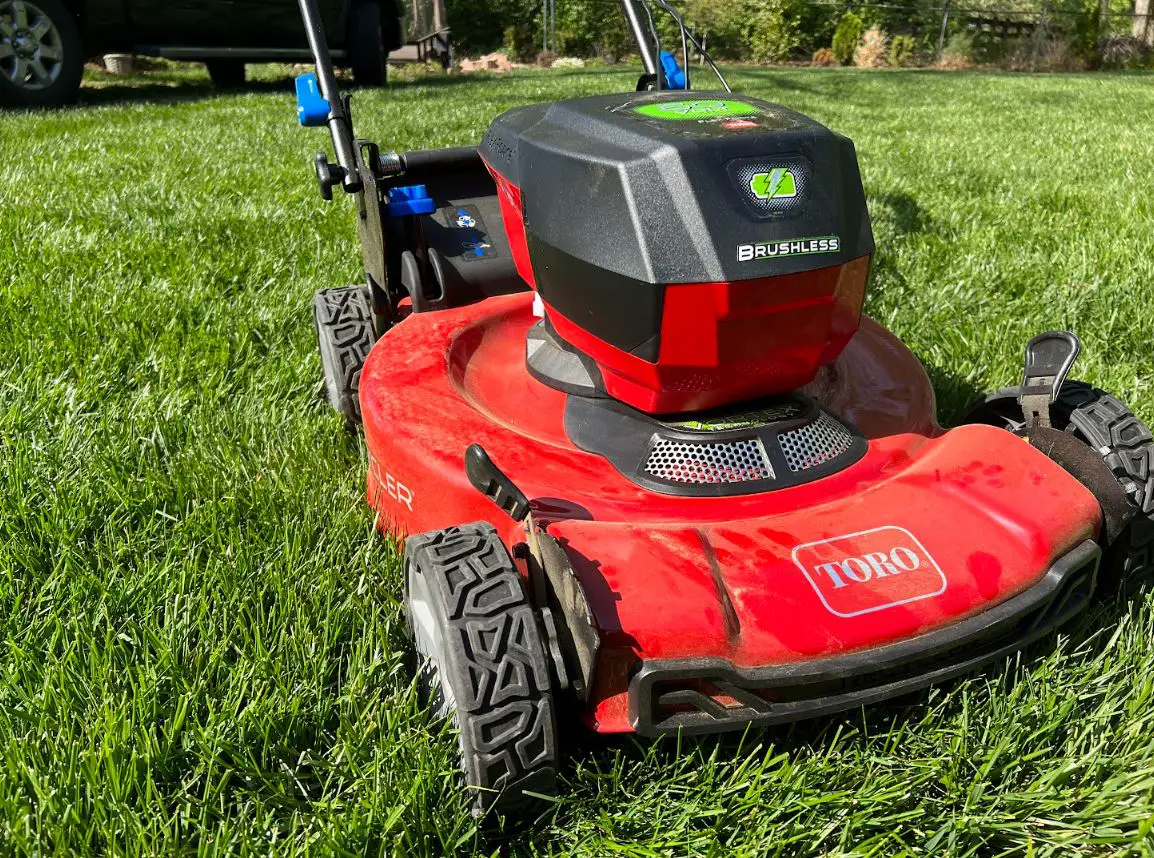A mulching blade on a lawn mower is a blade designed to finely cut grass clippings, leaves, or other debris. Mulching blades are great for fall weather or yards with mixed grass types or are significantly overgrown.
Bottom Line: For most homeowners, mulching blades should not be used for regular lawn mowing. A good analogy for mulching blades on mowers is like using a chainsaw to slice a cake. Mulching blades are overkill and will shred your grass and give it an uneven cut.
Mulching blades on Lawn Mowers: Explained
Most mulching blades on lawn mowers have a curvature that creates airflow and circulates and repeatedly cuts the same grass until it is finely shredded. Other mulching blades have teeth on the end that can cut up smaller pieces of debris and shred through leaves with no problem.
Some mulching blades have both teeth AND a curvature. All mulching blades have a longer cutting edge that allows for enhanced cutting.
Different types of mulching blades on lawn mowers
The two main types of mulching blades include curved blades and then mulching blades with teeth. Let’s take a look at both.
Curved mulching blades on mowers
Curved mulching blades are typically referred to as 3-in-1 mulching blades and sometimes come standard with lower-end lawn mowers. Curved mulching blades are heavier than normal blades and have a longer cutting blade (meaning the sharpened part is extended down towards the center of the blade).
My recommendation when it comes to curved mulching blades is to buy them separately from the rest of the mower. I would use the curved blade as an attachment during the Fall when your grass is super thick and leaves are piling up on your lawn.
High lift lawn mowing blades
High lift lawn mowing blades are the standard, thinner blades that are typically used with side discharge mowers. They are able to spin with more precision and provide a cleaner cut. The blade length is smaller so that the mower is able to chop-and-go without tossing around a ton of clippings.
My recommendation with high lift blades is to use them for the majority of the Spring and Summer before leaves start hitting the ground. High lift mowing blades will provide your lawn a clean, even cut.
What are Gator blades on a lawn mower?
Gator blades are mulching blades with specifically designed features including patented teeth and other designs that intensify mulching. Gator blades are made by Oregon products – a brand that makes chainsaw chains and other cutting tools.
Gator blades are great for highly intense mulching needs and are super aggressive.
Do I need mulching blades on a zero-turn mower?
In my opinion, mulching blades are not necessary for most zero-turn mowers. Zero-turn mowers provide so much power and cutting force that altering the blade is not necessary.
There is a time and a place for mulching blades on zero-turn mowers if the goal is to bag the clippings or leaves. A mulching blade may help cut the grass into finer pieces to make bagging more efficient. Otherwise – you can skip it.
Best mulching blades for lawn mowers: 2024 Edition
Here are some of the highest quality mulching blades you can add to your mower.
MTD Genuine Parts Mulching Blade with Adapter
The MTD mulching blade and adapter kit is great for 21 inch lawn mowers, both push and self-propelled. I like this mulching blade because it is inexpensive, fits just about every mower, and comes with an adapter to make sure it fits well on your mower.
If you look closely, you will notice that this is a curved-blade mower blade that creates a vacuum effect that finely chops your grass for you. If you have a classic Troy Bilt mower or really any 21 inch mower – battery powered or gas – this one is a great, cheap option.
You can grab this one for a really nice price with the adapter on Amazon.
Oregon 21 inch G5 Gator Blade
Oregon is the original creator of the Gator Blade. If you want an intense, aggressive mulching blade, then this is the one for you. The G5 Gator Blade has:
- Ability to fit most 21 inch mowers
- Sharp teeth on both ends of the blade
- Tungsten-reinforced blades for extreme durability
- Extended cutting length on the blade
Basically, the G5 Gator Blade will absolutely shred the living daylights out of any mulching job you need done.
It also sells for a super low price on Amazon.
Frequently asked questions about mulching blades
Should I put mulching blades on my mower?
You should put mulching blades on your mower if you want to finely chop up some leaves or are about to mow a super thick, out-of-control lawn.
Which is better, mulching or high-lift blades?
Mulching blades are better for finely cutting leaves and grass and high-lift blades are better for even, smooth lawn mowing.
Is it better to use a mulching mower?
There aren’t really mulching mowers, just mulching blades. I prefer using regular blades on any kind of mower and then adding the mulching blade on as needed.
How do I sharpen a lawn mower blade?
Check out this full guide about sharpening lawn mower blades step-by-step.
